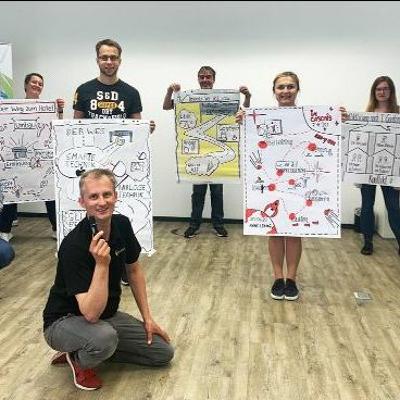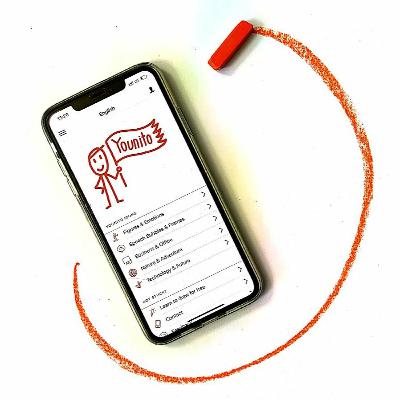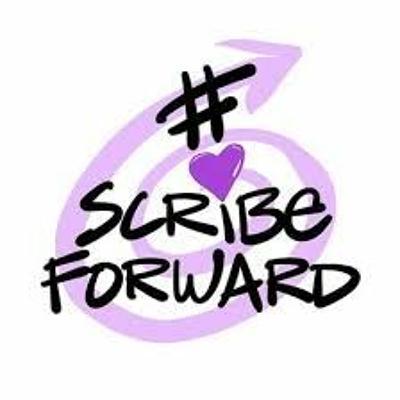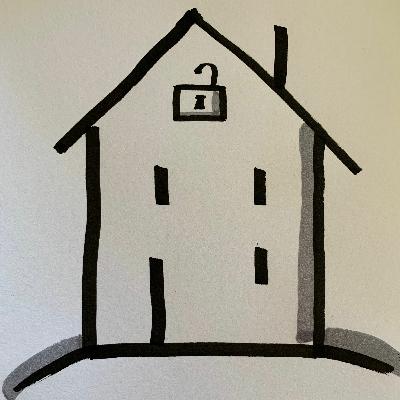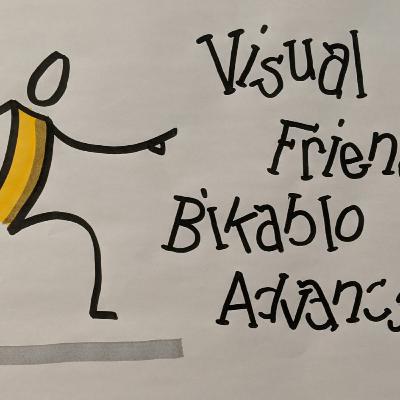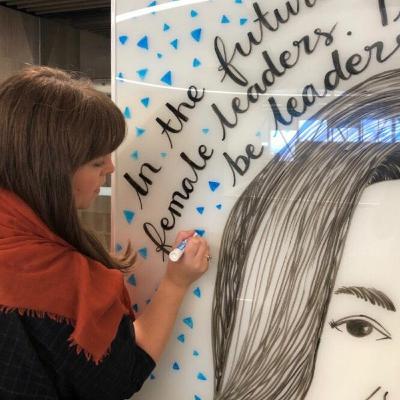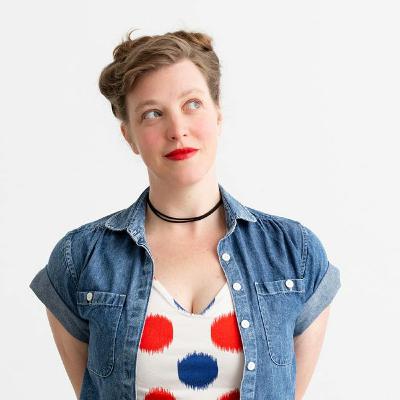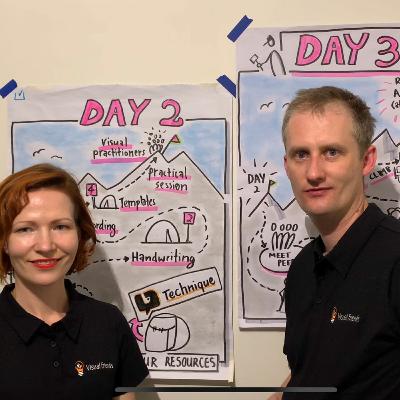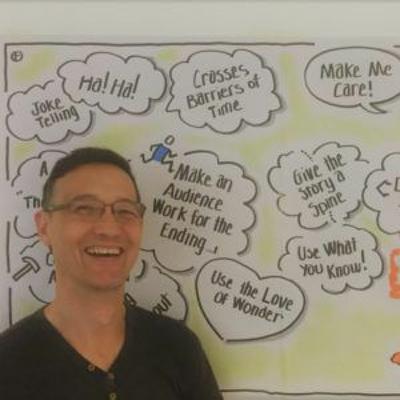Discover Visual Friends Radio - The Visual Facilitation Podcast Show
Visual Friends Radio - The Visual Facilitation Podcast Show

38 Episodes
Reverse
Marcel van Hove shares story with us about his move back to Germany from Australia, and the birth of Visual Friends Germany. We discuss how as an entrepreneur and small business owner he has grown his Australasian business to a global business, Younito the new visual collaboration training created this year, and also how he's found niche opportunities during the global pandemic such as creating new training content to upskill German teachers to successfully use visualisation and technology to work remotely.
Visual Friends proudly announce their latest visualisation and collaboration training offering and visual dictionary app, Younito.
We talk with Marcel van Hove and Danny Low of Visual Friends about where the idea for Younito came from, how it was developed, through to how it is implemented in class today. A visual dictionary app, aptly named Younito, has also been developed to compliment not only the training, but to share these unique sets of icons and templates with the wider visual community. Younito is available through the Android and Apple app stores for anyone to download and access a free subset of the Younito icons and templates to start.
Our conversation with two amazing generous visual practioners Angelique McAlpine and Heather Martinez about their initiative #ScribeForward. This is a unique and important project, born during the pandemic, to amplify and promote the work of visual practioners all over the world who currently volunteer their time and professional skill at events benefiting humanity.
A time of change is upon us, like none we have seen for generations. A time of vulnerability, but also opportunity too. In this episode of Visual Friends Radio we're joined by Marcel van Hove and Danny Low of the Visual Friends team to talk about how they're focusing on adaptability, innovation and channeling their creative power during the current pandemic.
What could be better than an Icon Jam? A Global Icon Jam!
We talk with Brisbane based Bikablo trainer Danny Low, Auckland based Visual Coach Yuliya Schamrel, and Visual Facilitator and Bikablo trainer Gill Cromhout from Breaking Ground Learning and Development in Cape Town about this exciting collaborative intercontinental event held in January 2020.
Interview with our Brisbane trainer Danny Low about Visual Friends' new training - Bikablo Advanced.
What you will learn, who it is useful for and how this traninig has come about.
In this episode we are talking to a talented graphic scribe, an illustrator and visual facilitator Alice Edy about courage.
Alice dared greatly and ended up scribing for Brene Brown herself. She tells us how overcoming fear has helped her create important career opportunities for herself, shares her advice about preparing emotionally for a scribing session and gives us her tips about failing publicly and how you can't grow creatively without making mistakes.
We loved talking to Alice about how stepping outside of the comfort zone allows you to direct and shape your career in an exciting and unique way.
Podcast notes: during our interview conversation Alice mentions Brene Brown, Heather Martinez, Kelvy Bird and Jessamy Gee.
In the latest episode of Visual Friends podcast we interview talented and fabulous Kate Baxter – a recognised expert in the global community of visual practitioners and an amazing graphic facilitator with passion for all things digital.
Learn about how Kate, a reluctant and shy scribe with background in fine art, went from thinking she can’t do it to successfully scribing for big clients all around the world. Find out what helped her transition from scribing on a white board to nailing it as a digital graphic facilitator. Kate shares advice on how to develop your own style and deal with difficult topics, talks about the challenges of this profession and what you need to succeed in this job.
We hope you’ll find it as interesting as we did. Enjoy!
I met Sarah Firth when I moved to Australia the second time in 2013 and she was for me THE graphic recorder and I admired and still admire the great art she produces. Sarah is an award-winning comic artist, graphic recorder, writer and animator based in Melbourne.
We learn how she grew up in Canberra and later travelled the world. We hear about sketchnoting and how it helped her to focus in school. How she started to have a career as an artist and how she got into graphic recording around 2010. She shares amazing stories about a major accident she had and how she got back into daily life using sketchnoting again while she was in the hospital.
Today she uses her skills to in very challenging environments, she likes to work for non-for profit organisations, for example, to work with people to overcome trauma. Sarah shares some tips about how you can improve your drawing skills over the years to become a rockstar in the field of graphic recording. With that please enjoy the episode and we look forward to welcoming you in person at VizConf on the 19th of October 2019.
An interview with Visual Friends co-founder, Marcel van Hove and one of our visual coaches, Yuliya Schamrel about a new and exciting program for our students - The 60 Days of Coaching. If you ever wanted to take visualisation skills to the next level, refresh your bikablo technique or develop a work related visualisation project, this is for you. Hosted by Natalia Tsygankova.
Melaine D'Cruze has been a visual thinker all her life. Through her school years and her career, she always took visual notes and doodled to focus and to remember ideas. She didn't know that there was actually a professional field for visual thinking until one day when she discovered the TED Talk from Sunni Brown, Doodlers, unite!
Melaine read the book, subscribed to an online course from the Doodle Institute, read several books and through that became a very good sketch note taker. She even got invited by the Harvard Business School to publish a blog post after visualizing one of their online courses. However, her main application for visualization and visual thinking is not at work. Her main application is in the field of educating her kids.
Melaine has two amazing boys, who are much faster understanding and accessing information when seeing them visually. She started to visualize ideas together with the boys and through that, they could memorize the content easily. The other boy stammered from time to time and with visual cue cards she could remind her boy to slow down whenever they stumbled. Today both boys are doing fine, and we'll talk more about ideas on how we can educate kids visually.
In summary, this episode is a statement to believe in yourself, follow your passion and let no one take you down. I hope you enjoy this episode with Melaine D'Cruze from Karachi, Pakistan.
A couple of words about Heather Martinez. Heather likes to live in the countryside and currently lives in Durango, Colorado in the USA. Heather is a visual practitioner and graphic recorder but is also an Agile guy like me or Danny.
She spends a lot of her time running virtual lettering classes for visual practitioners on LetsLetterTogether.com where you can improve your lettering skills on a 1:1 based via Zoom. Additionally, she will be offering 2 online courses associated with her new book and a Level Up Your Lettering starting in the spring.
In parallel, she runs her coaching practice where she offers life and art life coaching to artists. Here Heather believes that everyone can become an artist!
We talk about her whole life from the beginning where she grew up, where she chose to live and how she got into graphic facilitation. We learn how it feels being graphically recorded for the first time herself and what we as graphic recorders might need to consider when recording someone talk.
Last but not least, we talk about her new book which will have the title the ‘Lettering Journey’. Here she has a great plan for how she creates this book: She travels Europe and teaches lettering across Europe over the next month. As part of the training, she will take the participants out of the training room into the environment, walk the streets and look for the greatest street signs to practice together. Please have a look at her travel schedule here:
London: Wednesday, February 20 (fully booked)
Amsterdam: Saturday, March 2 (fully booked)
New York: 1 Day Bikablo + 1 Day Lettering Workshops, April 12-13
San Francisco: Level Up Your Lettering with Heather Martinez, May 30-31
Other locations may include:
Cologne, Braunschweig, and Frankfurt in Germany in early March.
Locations to be announced, Please email Heather for details.
Now you might think Europe is far away and I can’t travel right now! - Here we are delighted that Heather has confirmed to be our keynote speaker for VizConf 2019. Additionally, she will also run a pre-conference course about lettering the day before VizConf and might even take everyone on a lettering tour through Melbourne.
Stay tuned and make sure you get your Visual Friends newsletter updates so that you don’t miss the spot in her class.
Let me introduce to you Danny Low. Danny is not only a bikablo® trainer and partner at the Visual Friends. He is also a very good friend of mine and in many ways, we are very similar. We talk a bit about that but we forgot to talk about one great story. So in the early days when I met Danny, he told me that he will take time off and travel with his family around the world. He told me that he would like to pass on some of the experiences he and his wife Anna had and to show the kids the world. With that, we pretty much hit the core DNA of Danny. He likes to pass on his life experience to others - not only to his kids but also to his students at the Visual Friends. He likes to help others and is a great mate that everyone would like to have as a friend. We follow his personal journey, learn how to visualise legal contracts, hear about project management, agile coaching and how he became part of the Visual Friends. For me, Danny’s story is another great example of what can happen in life when you follow your passion and make a couple of choices at the right time. Please welcome our lawyer and Kung-Fu master Danny Low from Brisbane.
Do you remember the time when Apple was founded or maybe have seen the movie ‘Pirates of Silicon Valley’? Until I met Dean, I never had met a person who worked at Apple at that time when the first Macintosh and with that the first graphical user Interface (GUI) was released to the world.
Dean knew that someone had to explain this new GUI-thing and therefore probably was one of the first trainers on the planet to teach how to use a GUI.
What strikes me when talking to Dean is his wide range of professional skills. You might know that we all learn by using different modalities. Some people prefer to access new information by reading or learn better by writing it down. Others need to hear it or visualise ideas. Different people again like to touch things and have a quick understanding when doing something with their hands. Through the years we find our preferred way of learning and develop it as your core skill. Dean is different here. Until I met Dean, I hadn’t met a person who has such a high experience in all those different modalities. He is not only a visual problem solver, but he has also an educated as an opera singer and music composer.
Additionally, he believes in the power of thinking with our hands and therefore is a facilitator for LEGO SERIOUS PLAY where you use LEGO bricks to coach people by building something with their hands. I am delighted to introduce to you Dean Meyer from New York.
This is the second part of the interview with Sunni Brown record on the 18th of September 2018:
In the first part of this episode, you learnt a lot about Sunnis Brown's life and her early years as an entrepreneur from strangling to make a living to be one of the top speaker and best-selling author in the field.
We followed her journey step by step, from working for the Grove, one of the first visual thinking consultancies on the planet before she moved to Austin, Texas where she started her own business.
In the second episode, We find out more about her work as an author and why riding a dragon and writing a book is a similar challenge. We talk about the serendipity that she got invited to TED2011 and how she prepared 4 months for the 6 minutes that has inspired more than 1.4 million people.
We compare the skill of graphic recording with sketch noting, do a “quickly ask round” and brainstorm together about the upcoming keynote at VizConf 2018.
We hear about her experience at TED, her keynote at VizConf 2018 and her work on the upcoming book DEEP SELF DESIGN™ that helps you to reach your goals in life.
Enjoy!
In this new episode, you will learn a lot about Sunnis Brown’s life and her early years as an entrepreneur from strangling to make a living to be one of the top speaker and best-selling author in the field.
For example, when Sunni was quite young she wrote to her mum a letter and told her that she either wants to become a doctor or - if that doesn’t work the president of the united states. This might seem like a funny kids letter but this letter has guided Sunni through her life. Not growing up in a privileged family she had to believe in herself and work hard for her success.
This guiding principle actually led her to her upcoming book called DEEP SELF DESIGN™ which is based on the idea that you are in control of your own life. In fact, we all are in control of our own lives and our mind is often the biggest obstacle why we don’t reach our full life potential.
We follow her journey step by step, from working for the Grove, one of the first visual thinking consultancies on the planet before she moved to Austin, Texas where she started her own business.
We find out more about her work as an author and why riding a dragon and writing a book is a similar challenge. We talk about the serendipity that she got invited to TED2011 and how she prepared 4 months for the 6 minutes that has inspired more than 1.4 million people.
We compare the skill of graphic recording with sketch noting, do a “quickly ask round” and brainstorm together about the upcoming keynote at VizConf 2018. By the way it on the 13th of October and the tickets selling out quickly.
We recorded more than 90 minutes and therefore cut this recording into two episodes. This one will start from her childhood through her first book “Gamestorming” and her second book “The Doodle Revolution” and is a great inspiration for any creator or entrepreneur.
In the second episode, we hear about her experience at TED, her keynote at VizConf 2018 and her work on the upcoming book DEEP SELF DESIGN™ that helps you to reach your goals in life.
Enjoy this episode with Sunni Brown record on the 18th of September 2018.
Imagine the following: In order to make the most of the opportunity to attend a visual practitioner conference for the first time - you write a book, bring it along and sell it there. This might sound a bit crazy but this is exactly what Jill Greenbaum did when she attended her first IFVP conference in Pittsburgh in 2012 and it has worked out quite well as Jill is selling her book “How to Major in You and Find the Right College” ever since.
But of course, Jill didn’t write a book out of the blue. She looks back on a great career in the field of education. She has studied Psychology and Education at Clark University before she became a teacher, principal and administrator in various settings in New York City. She ran two non-for-profit programs before she started working for herself in 1996.
We talk about her coaching practice and her work as a facilitator with POINTS OF YOU® from Israel who provides inspiring life coaching cards that you can use for live coaching games. Last but not least we look at her upcoming bikablo® trainings in the US that she hosts, her work on the IFVP board and learn that she even has been to Tasmania recently!
You probably agree with me when I say you can’t change people!
Even if you have the best idea on the planet not everyone will stop working in the old way and jump onto the new idea immediately. If that would be the case all people in the Tech-Industry would be Lean-Agile-Design-Thinking-Visual Facilitators. So what can we do to inspire others and facilitate change? First, let’s talk about why not everyone follows you…
Every Person is Different
I often experience that people might not listen to me but believe in the same idea explained by someone else. The reason here is that they find it hard to identify themselves with my person but can see themselves and understand the idea through another coach. So it is not about the idea it is about the person who presents the idea. By the way, that is a great reason why it is hard to change the world alone.
Repeating a Great Idea
Another important insight is that hearing a great idea through different channels makes it easier for our brain to believe that it is true. Sadly that is true for fake news as well as for helpful great ideas like bikablo®. If you hear them more often, through different channels - they become real in our brain.
First Follower
In every job as an agile coach I tried new things almost every day. I shared the idea quickly across the companies I worked hard to inspire others but not every idea went viral. You need a first follower to validate that the idea is great. The first follower shows that it is okay to follow and to join in. A great example of what I mean is this “Dancing Guy” who starts a party in the park. Here is what happens: One dude starts dancing and another person joins in - soon everyone is dancing but it needs the first follower to validate this behaviour. Watch the full video here.
Prophet In Your Own Land
Last but not least it often helps to add an outside perspective by inviting a external person speaking about your idea. In this way skeptical people might be more open to ask hard questions as they don’t have to work with him the next day. The fresh perspective of an outsider around your idea also helps to reingnite the fire and keeps the idea alive.
Why I am telling you this?
You have learnt to draw using the bikablo® technique and if not come to one of our next trainings. You know now that it is so much more powerful to convey your message with words and pictures and that it enables much higher level of collaboration because you use use all four modalities to communicate. Someone speaks and you listen. But you also visualise it and if you share the pen and draw together you actually have a kinaesthetic experience together. There is no better way as to communicate and collaborate with a pen on the whiteboard. However when you are back at your company you need to connect to others inside your company to start a visual revolution. For that we suggest three steps to spark the change.
Step #1 - Let's run a brown bag session at your company
Step #2 - Through that you will be able to identify your visual friends inside your company
Step #3 - Host a Lunch & Learn to connect, learn and help each other working on a whiteboard.
I hope this episode helps you to find your visual friends inside your company and we would like to point out that the first three people who book a brown bag session will get this workshop for free. Just book your brown bag session at www.visualfriends.com/brownbag
I think I have to confess something to you guys. April this year I recorded an amazing podcast with John Hibble about his venture, The Facilitation Starter. John Hibble is an experienced facilitator with more than 10 years in the field.
After I recorded this podcast in April my life became quite busy as I started building a house in May and had a newborn baby in July. That is the reason why this podcast stayed on my hard drive for quite a while. Now it's time to unveil this great conversation about workshop preparation from the session designed over delivering a workshop to how you capture insights.
Over the last month things have changed slightly. I'm very happy to announce that John is also now a certified bikablo® trainer like Martin and I, and together we run as the Visual Friends bikablo® trainings in Australia and New Zealand.
If you would like to say hello to John, please add him on LinkedIn or just come to one of the next trainings. We just finished the scheduling for the trainings in Q1 2018. We run the trainings as normal in Sydney, Brisbane and Melbourne. We are also back in Perth and Auckland and hope that we get a training running in Hobart at the beginning of the year.
Now let's do the time travel and go back to April and listen to John Hibble from the Visual Friends.
This is the second part of the interview with Antonio Meza. In the first part we talk about Antonio’s life story and his career as an NLP (neurolinguistic programming) trainer and coach. We looked at the combination of NLP and graphic facilitation and how to record sessions using an iPad. In the second part Antonio gives you an introduction into symbolic thinking.
Everyone uses symbolic thinking and we don’t have to learn it. For example a person with hanging shoulders and a sad face would be seen as not resourceful while a person on top of the mountain in superman posture would be seen as very energetic. Here it doesn’t matter whether it is a real person or a stick figure drawing.
Symbolic thinking describes the process of creating an internal representation of a situation, scene or thought. We use all of our senses to imagine a situation and create our own internal representation. Every person is different so that everyone creates his own emotional reaction about the scene.
Understanding the concepts of symbolic thinking makes you a better graphic recorder as you can use those metaphors to tell more engaging stories even about the most boring topics. Just ask what the topic means for the people in your story and find the right metaphor.


